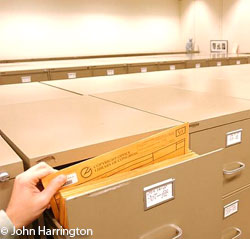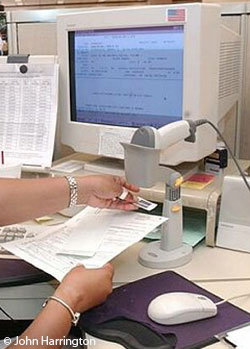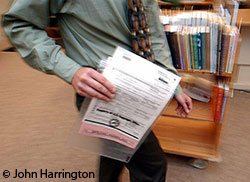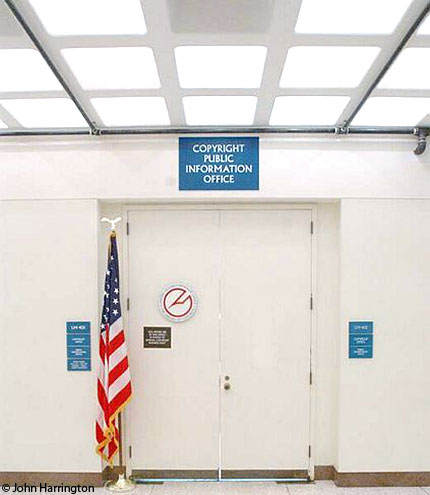 A few years agoor so, Getty (GYI) introduced Photographer's Choice, whereby Getty's contributors were paying $50 to have their image considered for inclusion in the Getty archive. By paying this, you didn't get premium page position, you just got included.
A few years agoor so, Getty (GYI) introduced Photographer's Choice, whereby Getty's contributors were paying $50 to have their image considered for inclusion in the Getty archive. By paying this, you didn't get premium page position, you just got included.
A number of photographers justified this in their mind by looking at the average sale of $500 for online sales, and much higher for print sales, felt that it was a worth it to take a chance at spending $50 to do so. Photographers were very selective in what they posted, because it had a direct cost to them. They looked at the numbers - if one sale of $500 was made, and they earned their 40%, that generated about $200 for them. Thus, it would be a zero-sum game if, for every four images they uploaded, one sold. It was slightly better for an average $900 print sale. Now, the tables have been upended. The $50 cost to photographers remains, but in order to cover the cost of just one, the revenue of $12.50 or so that the photographer gets has to be earned over 4 times, in order to cover the cost of one upload. Surely now, it's not Photographer's Choice, but rather, it's more aptly titled Photographer's Chance. What's also not discussed, is the abismal "all you can eat", or "subscription model", that Getty has had ongoing. One photographer I've spoken with reviewed their statement with me recently, and showed their share of a subsciption sale as $2.16 for an image that went online.
(Continued after the Jump)
According to the $49 FAQ, the "500KB 72 dpi file...depends on a few variables such as color versus black and white." Ok, so we'll presume that the 500kb file is color, and they say " this is designed as an ongoing product, not a limited-time offer." The files are listed as "web res", not "for the web only." So, "Royalty-free images may be used multiple times for multiple projects", thus, any RF image can be used repeatively in both print and electronic. This may not be explicitly stated, however, when it's said that " Rights-ready images may be used in web or electronic media for commercial or editorial projects such as websites or email for three months" that specifically stipulates electronic only, it becomes more clear. Further, this isn't about a high school book report. IBM or General Motors can use the files for the same price, with millions of impressions. And then there's "Rights-managed images may be used in one commercial or editorial website, email or mobile project for three months." Here's my bet on this three months concession they made. They either won't enforce it, or, they will piss of their clients when, 90 days after download an e-mail goes out to the clients saying they have to pony up again, or delete the file from their site, or, the Getty legal department will become overburdened with chasing all these $49 unauthorized uses, that they won't have time for anything else, and then, in turn, they just won't pursue all the overdue payments, and clients will get the idea that it's open season on paying once for Getty images, and never bother to renew. Or, when they do pursue the claim, and end up in court, a opposing counsel will claim selective enforcement, demonstrating that the claim before the judge is just one of only 1% of the infringements that Getty is pursing, and thus, since Getty doesn't agressively pursue all claims, that the one in question should be either dismissed, or diminished. It's a downward spiral to be sure.
And While Getty is saying here, "This means you can get your hands on any creative, news, sport, entertainment or archival image for just $49.*", that asterisk directs readers to the "fine print", which reads "*This pricing may not be combined with any other offers, discounts or pricing agreements and does not include images from Image Source or Arnold Newman Collection, or select editorial images." So, somehow, Arnold Newman got exempt (and deservedly so), so did Image Source, and where they refer to "select editorial images", I draw the educated assumption that they are referring to breaking news event images and those which they have exclusive rights to, among others. This image of Brad Pitt on People's website is $49 to People, unless, of course, it falls into the "select editorial images" category.
Boy, there sure are several windows of exception there. But, consider carefully the stipulations, "72 dpi", which is "web res", and further, has a maximum of "500kb." How does that math work, in reverse? Well, a 150dpi file, which can be used in newspapers and other print outlets, allows easily for a 2.3" x 3" file. A 300dpi file is 1.2" x 1.6". To give you an idea, here's a file of mine that I sized to fit the 500kb size, and that's not a small file to be sure.
According to a press release dated 9/21/07, "The Association of Photographers (AOP) have joined forces with an international coalition of photographic trade associations, led by The Stock Artists Alliance (SAA), to protest at Getty Images plan to launch a $49 web use (500 px wide, 72 dpi) across all licensing models (RM, RR, RF)."
From the release, AOP Awards Gold Winner and IPA Professional Photographer of the Year 2007, George Logan, said:"I have been becoming increasingly disenchanted with Getty for some time and this $49 'promotion' is the final straw. I find it truly insulting that I might receive approx £12.50 per image sold. I do not want to be associated with a company who would sell off my work in such a cheap and crass manner.
This is not what I got into photography for and I know I am not alone...every other photographer I have spoken to, including many of their major contributors, feels the same way.
I shall no longer submit images to Getty and will withdraw my existing collection at the soonest opportunity.
Well respected photographer, and AOP Member, Jo Sax, said:"$49 for a digital media license is an affront to the time, funding and energy that goes into producing a high quality creative photograph.
I am not prepared to have my work devalued this way.
Additionally, negotiating for a fair digital media fee on commissioned work may become a real sticking point. I work with several agencies that also license stock from Getty. The disparate pricing this new Getty 'product' introduces will confuse the market at every level.
I am terminating my contract with Getty Images, and I would like to ask other GI photographers to examine this situation carefully and then respond appropriately.
So, it seems that Getty's decision to do this will diminish, in a qualitatively and quantitatively significant way, the content in their archives. I have spoken with several Getty contributors stateside, and their tact is the same. They're ceasing providing the high quality images they're known for, and also are considering (and some planning on) yanking their images, and Getty's right to license them to photo buyers. Some are going to Alamy, others to PhotoShelter, or Digital Railroad, others to other solutions.
Note to Getty's hard drive suppliers, your orders will be slowing down. Note to Getty's scanning and keywording services - you will soon have more time on your hands. And, note to the Getty photo editors - a few of you should be polishing your resumes, as it's belt-tightening time at GYI.
Please post your comments by clicking the link below. If you've got questions, please pose them in our Photo Business Forum Flickr Group Discussion Threads.
[More: Full Post and Comments]
 This area is the Correspondence Control Unit. Here, should there be a problem with your registration, your paperwork will be placed on hold until you respond the correspondence sent to you from the copyright office.
This area is the Correspondence Control Unit. Here, should there be a problem with your registration, your paperwork will be placed on hold until you respond the correspondence sent to you from the copyright office.  This area is the Data Processing Unit. The CO staff affix a bar-code to your registration, assigning it a number. This number is entered into the Library of Congress copyright office database, which is accessible both from the card catalog area of the Library, as well as via the Library's online services.
This area is the Data Processing Unit. The CO staff affix a bar-code to your registration, assigning it a number. This number is entered into the Library of Congress copyright office database, which is accessible both from the card catalog area of the Library, as well as via the Library's online services. Nearing the end of the process, a Copyright Office staff person images (i.e. scans from analog printed sheet to a digital file) the completed form, once all the appropriate registration numbers have been applied to the form, and sends the item to be printed with the color logo of the Copyright Office.
Nearing the end of the process, a Copyright Office staff person images (i.e. scans from analog printed sheet to a digital file) the completed form, once all the appropriate registration numbers have been applied to the form, and sends the item to be printed with the color logo of the Copyright Office. The final registration form, complete with color logo, are sent to the person who has registered their work, after final inspection by a Copyright Office staff person.
The final registration form, complete with color logo, are sent to the person who has registered their work, after final inspection by a Copyright Office staff person. Here, a Copyright Office staff person, or the general public, can look up a specific registration, and review and print an electronic version of the form, which is accessible from the card catalog area of the Copyright Office (as seen here). While you may get your form within a few months, they may not appear online for a few more months following that.
Here, a Copyright Office staff person, or the general public, can look up a specific registration, and review and print an electronic version of the form, which is accessible from the card catalog area of the Copyright Office (as seen here). While you may get your form within a few months, they may not appear online for a few more months following that. There are a number of steps involved in the process of completing a copyright registration. The Copyright Office offers an expedited service, where you can have your entire registration completed within 5 to 10 days. A person is assigned to personally shepherd your registration through the many steps of the process, traveling to the many offices with your registration in hand, seeing to it that it gets done. This is a premium service, costing several hundred dollars per registration.
There are a number of steps involved in the process of completing a copyright registration. The Copyright Office offers an expedited service, where you can have your entire registration completed within 5 to 10 days. A person is assigned to personally shepherd your registration through the many steps of the process, traveling to the many offices with your registration in hand, seeing to it that it gets done. This is a premium service, costing several hundred dollars per registration. There are a number of steps involved in the process of completing a copyright registration. Here, in the Materials Control Unit, librarians are asked to come in and review selected items presented for registration which the Library feels it would like to have both copies of the item being registered for the Library's collection. It is a rare case that the Library of Congress would request a photograph, but it retains the right to do so. Here, the Library has selected, and will correspond with the authors of a number of books to request copies for the Library's collection.
There are a number of steps involved in the process of completing a copyright registration. Here, in the Materials Control Unit, librarians are asked to come in and review selected items presented for registration which the Library feels it would like to have both copies of the item being registered for the Library's collection. It is a rare case that the Library of Congress would request a photograph, but it retains the right to do so. Here, the Library has selected, and will correspond with the authors of a number of books to request copies for the Library's collection.
